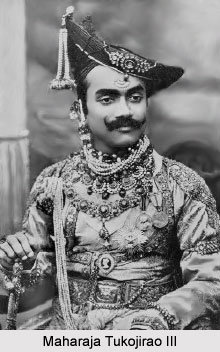 Tukojirao III was an eminent ruler or Maharaja of the princely state of Dewas, which is located on the Malwa plateau and currently in the west central part of the Indian state of Madhya Pradesh. It is the administrative center of the district of Dewas and around 150 km south west from Bhopal, which is the capital of the state. The Maharaja of Dewas was born on 1st January 1888 and reigned over the territory from the year 1900 to 1937. After the death of Raja Krishnajirao II, Tukojirao III succeeded him and ascended to the royal throne or gadi of the princely state of Dewas. In the year 1918, on his 30th birthday, the British East India Company granted him the title the first Maharaja of Dewas senior. Sir Tukojirao III escaped to Pondicherry(now known as Puducherry), which was in French India on 26th July 1934 and instructed his only son Vikramsinhrao Tukojirao or Shahoji II to supervise and manage the affairs of the state of Dewas senior.
Tukojirao III was an eminent ruler or Maharaja of the princely state of Dewas, which is located on the Malwa plateau and currently in the west central part of the Indian state of Madhya Pradesh. It is the administrative center of the district of Dewas and around 150 km south west from Bhopal, which is the capital of the state. The Maharaja of Dewas was born on 1st January 1888 and reigned over the territory from the year 1900 to 1937. After the death of Raja Krishnajirao II, Tukojirao III succeeded him and ascended to the royal throne or gadi of the princely state of Dewas. In the year 1918, on his 30th birthday, the British East India Company granted him the title the first Maharaja of Dewas senior. Sir Tukojirao III escaped to Pondicherry(now known as Puducherry), which was in French India on 26th July 1934 and instructed his only son Vikramsinhrao Tukojirao or Shahoji II to supervise and manage the affairs of the state of Dewas senior.
Maharaja Sir Tukojirao III of Dewas senior was married to Maharani Radhabai Maharaje Sahib Puar, who was his first wife. The royal couple had only one son Vikramsinhrao Tukojirao. Tukojirao III died at the age of 48 on 21st December 1937 in Pondicherry, in exile. He was succeeded by Vikramsinhrao Tukojirao, who later abdicated the throne of Dewas in the year 1946 and became Shahoji II of Kolhapur.
Titles of Tukojirao III
Sir Tukojirao III of the princely state of Dewas held various titles and styles through out his reign. These are mentioned as follows-
* Shrimant Keshavrao Anandrao Puar (1888- 1900)
* His Highness Kshatriya Kulavatana Sena Sapta Sahasri Senapati Pratinidhi, Raja Shrimant Tukojirao III Puar, Raja of Dewas Senior (1900- 1911)
* His Highness Kshatriya Kulavatana Sena Sapta Sahasri Senapati Pratinidhi, Raja Shrimant Sir Tukojirao III Puar, Raja of Dewas Senior, KCSI (1911- 1918)
* His Highness Kshatriya Kulavatana Sena Sapta Sahasri Senapati Pratinidhi, Maharaja Shrimant Sir Tukojirao III Puar, Maharaja of Dewas Senior, KCSI (1918- 1937)
Honours of Tukojirao III
Maharaja Tukojirao III was honoured a number of times, which are mentioned below-
* Delhi Durbar Gold Medal (1903)
* Delhi Durbar Gold Medal (1911)
* Knight Commander of the Order of the Star of India- KCSI (1911)
* King George V Silver Jubilee Medal (1935)



















